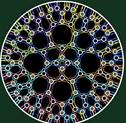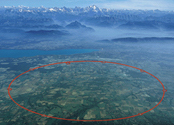The Doom of Spacetime
Why It Must Dissolve Into More Fundamental Structures
Nima Arkani-Hamed
Professor, The Institute for Advanced Study, Princeton, and
A. D. White Professor-at-Large, Cornell University
Video
You can also watch this video on the PSW Science YouTube Channel
Videography by Nerine and Robert Clemenzi, Edited by Nerine Clemenzi Copyright © Philosophical Society of Washington. All rights reserved.
About the Lecture

Space-time and Quantum Mechanics are the pillars of our modern understanding of fundamental physics. However, there are storm clouds on the horizon indicating that these principles are approximate and must be replaced with something deeper. The union of quantum mechanics and gravity strongly suggests that “space-time is doomed”, and there are related indications of fundamental limitations to quantum mechanics in both the early and late universe. This talk will review these paradoxes and describe indications for a new picture where space-time and quantum mechanics will be seen to emerge hand-in-hand from more primitive principles, making contact with new areas of mathematics. The talk will present a concrete example of how these ideas work in the context of particle collision experiments of the sort performed at the Large Hadron Collider”.


About the Speaker

Nima Arkani-Hamed is a world-renowned theoretical physicist with wide-ranging interests in fundamental physics, from high-energy physics and string theory to cosmology and collider physics. He has made ground breaking contributions in several areas of fundamental physics and is considered one of the most important theoretical physicists working today. He is a tireless educator and an entertaining and highly informative speaker with a unique ability to communicate complex theoretical ideas. Nima earned a BS in mathematics and physics at the University of Toronto and a PhD in physics at UC Berkeley, for work on supersymmetry and flavor physics. After his doctoral studies, Nima went to the SLAC National Accelerator Laboratory at Stanford University where he established an enduring collaboration with Savas Dimopoulos developing theories of fundamental physics involving large extra dimensions. He then joined the physics faculty at UC Berkeley. When he visited Harvard University, on a leave from Berkeley, he began working with Howard Georgi and Andrew Cohen on the idea of emergent extra dimensions (“dimensional deconstruction”), leading to the development of little Higgs theories. He joined Harvard as a Professor of Physics continue this work and then joined the Institute for Advanced Study in Princeton, where he currently is Professor of Physics. Concurrently, NIMA is an A.D. White Professor-at-Large at Cornell University Among many honors and awards, Nima is the recipient of the Phi Beta Kappa award for teaching excellence at Harvard, The Sackler Prize from Tel Aviv University, The Gribov Medal of the European Physical Society, the INFN-Pisa Gamberini prize and Packard and Sloan Fellowships. Nima is a Fellow of the American Academy of Arts and Sciences, Delivered the Messenger lectures at Cornell University, and is the inaugural awardee of the Fundamental Physics Prize. He also is one of the physicists featured in the award-winning documentary film “Particle Fever”.
Minutes
President Larry Millstein called the 2384th meeting of the Society to order at 8:02 p.m. President Millstein announced the order of business, announced the evening’s lecture would be livestreamed on the internet, and welcomed new members. The minutes of the previous meeting were read and approved. President Millstein then introduced the speaker for the evening, Nima Arkani-Hamed, Professor at Princeton University and Cornell University. His lecture was titled, “The Doom of Spacetime.”
We have studied fundamental physics for 2,000 years and understand the field very well. So, Arkani-Hamed said, it is particularly jarring when something that seemed like an essential element of how we think about the universe turns out to be wrong. He said that where we are today.
20th century scientists revolutionized physics with the theories of quantum mechanics and spacetime, which together form quantum field theory. Those concepts led to predictions accurate up to 12 decimal places, when tested. And that accuracy is what makes doubts about their accuracy so disturbing.
Arkani-Hamed then described the two “storm clouds” he sees for spacetime and quantum mechanics. The first storm cloud suggests that spacetime is doomed. The second, that quantum mechanics are limited.
To explain the first cloud, Arkani-Hamed presented a thought experiment. To see what exactly is going on at arbitrarily small distances, we must use high energies. In a world without gravity, there is, in principle, no limit to scaling the size of the detector to see what is going on at increasingly small distances. But we live with gravity, and where there is too much mass, we get a black hole that traps light – meaning that if we build too big a detector, we will create a black hole that will prevent us from seeing what happens at the smallest distances. Thus, gravity limits our ability to measure spacetime, which means our current understanding of spacetime is merely approximate and not fully accurate.
Similarly, the second cloud is explained by the problem of measuring quantum mechanics. To measure such quantum observables, our precision improves by how many measurements we take. But, to take the infinitely many measurements required to reach almost exact precision, would require an infinitely large measuring apparatus, which is again limited by gravity. This limitation means quantum mechanics is also an approximation.
Since spacetime and quantum mechanics are limited and approximately, Arkani-Hamed said they cannot be fully accurate. To be fully accurate, we must rethink our most basic understandings of physics, as there are no measurements of any sort in the interior of space and time that can belong as precise properties of the world.
Arkani-Hamed’s believes both spacetime and quantum mechanics will emerge together from new principles about the fundamental of physics. To find these new principles, we must consider how to approach the problem. As examples, Arkani-Hamed described how 20th century physicists re-thought determinism, and how Richard Feynman’s intimidating method of doing physics reduced to simple formulas. As scientists did in those instances, we must rethink the fundamentals of physics to find the simple truths.
In current research, Arkani-Hamed says physics and mathematics are working on the same questions with radically different approaches. He is optimistic those diverse approaches will bring about radical redevelopment and maybe in 20-50 years bring about a new grand unified theory.
President Millstein then invited questions from the audience.
One member asked whether geometry might be the primitive concept to build on. Arkani-Hamed said we are too early in our approach to re-thinking physics to believe that what we already know is the real thing. He cautioned that we must sever as much of the familiar language and concepts as possible from any new theory, stressing that we must push forward into completely new territory.
A guest asked what rules the speaker relied on to present proposed new principles. Arkani-Hamed responded that there are no rules, yet, but that we have enough data to know that certain results are certain. We can thus use that data to test the viability of new language and new theories.
After the question and answer period, President Millstein thanked the speaker, made the usual housekeeping announcements, and invited guests to join the Society. At 10:08 p.m., President Millstein adjourned the 2,384th meeting of the Society to the social hour.
Weather: Clear
Temperature: 7.8°C
Attendance: 159
Respectfully submitted,
James Heelan
Recording Secretary